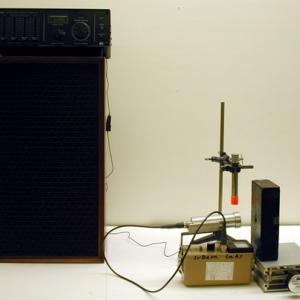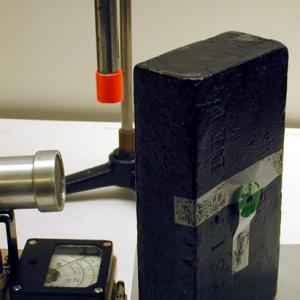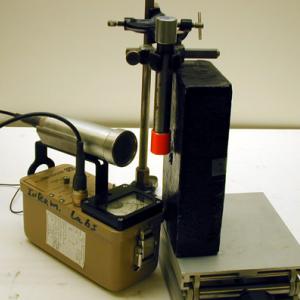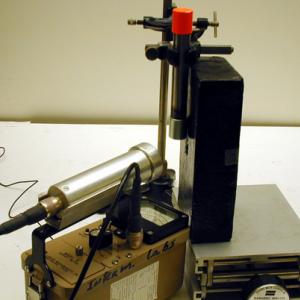College of Liberal Arts & Sciences
7D30.30 - Magnetic Deflection of Beta Particles
Take the Strontium 90 source to one side of the lead brick with the hole in it. This should collimate the particle stream to a single beam by having the particles travel through the hole in the brick. Place the survey meter directly in front of the hole with the detector about 4'' away. A very active count rate should be heard. Move the pole of the Neodymium magnet in place directly above the particle stream. The count rate should fall almost to background. The particle beam can be reacquired by moving the survey meter in an arc to the right or the left depending upon which pole of the magnet is above the particle stream. Typical bend of the particle beam is about 30 degrees.
- Forrest I. Glick, "Convenient Absorbers for Beta Shielding Experiments", TPT, Vol. 10, #1, Jan. 1972, p. 39.
- James F. Moore, "Beta Energy Using Modified Millikan Apparatus", TPT, Vol. 10, #1, Jan. 1972, p. 47.
- Sherwood Parker, "Relativity in an Undergraduate Laboratory - Measuring the Relativistic Mass Increase", AJP, Vol. 40, #2, Feb. 1972, p. 241.
- Marjorie Malley, "The Discovery of the Beta Particle", AJP, Vol. 39, #12, Dec. 1971, p. 1454.
- W. Bolton, "The Effect of Magnetic Fields on Beta and Gamma Radiation", Book 3 - Atomic Physics, Physics Experiments and Projects, 1968, p. 63-64.
Disclaimer: These demonstrations are provided only for illustrative use by persons affiliated with The University of Iowa and only under the direction of a trained instructor or physicist. The University of Iowa is not responsible for demonstrations performed by those using their own equipment or who choose to use this reference material for their own purpose. The demonstrations included here are within the public domain and can be found in materials contained in libraries, bookstores, and through electronic sources. Performing all or any portion of any of these demonstrations, with or without revisions not depicted here entails inherent risks. These risks include, without limitation, bodily injury (and possibly death), including risks to health that may be temporary or permanent and that may exacerbate a pre-existing medical condition; and property loss or damage. Anyone performing any part of these demonstrations, even with revisions, knowingly and voluntarily assumes all risks associated with them.



